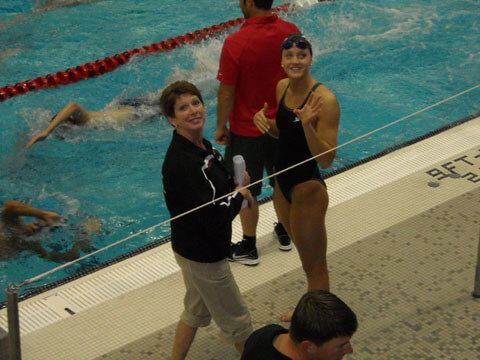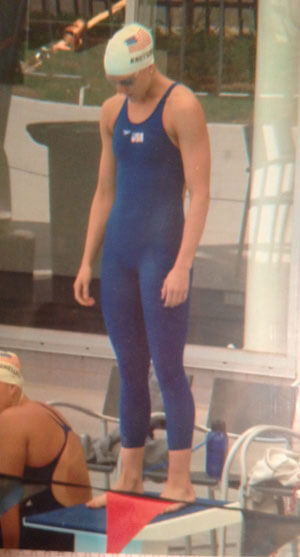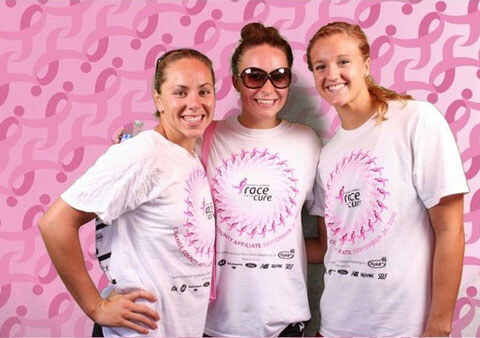Dagny Knutson’s Journey: How a Troubling Eating Disorder Consumes a Rising Star; Full Story
Feature by Shoshanna Rutemiller
PHOENIX, Arizona, August 27. THE entire swimming community perked up its ears as news started spreading that twenty-year-old Dagny Knutson, reigning World Champion in the 800 freestyle relay, was skipping out on 2012 Olympic Trials. It couldn't be true.
Comments flooded into online message boards, some of them biting: “Talk about a white-hot swimming star two years ago that faded super fast. What's the real story?”
The real story starts with a rewind to January 2012, at USA Swimming's Austin Grand Prix meet. While her competitors were preparing for the first night of finals, then-nineteen-year-old Dagny Knutson was battling tears. She had been making herself sick for almost a year, and after struggling through two events in prelims, recognized her eating disorder had finally gotten the better of her.
“It was time to warm up and I was in tears trying to decide what to do,” says Knutson. “I was hysterical. [Olympian] Dana Vollmer saw I was upset … she [gave me a hug and] told me it would be ok.”
Through the tears, Knutson realized she could not continue her charade. Things were not ok, and she needed to leave. “I grabbed my stuff, told Coach [Gregg] Troy I was going home, and called to change my flight.”
Succumbing to an eating disorder caused this promising star, whose fastest times would have made finals in the 2008 Beijing Olympics, to fall quickly. Knutson was a four-time short-course National Champion in 2009 and 2010. She was an American Record holder. She won gold medals in international competitions. With only a few days until her 20th birthday, Knutson should have been riding the upswing on the pendulum of success.
Unfortunately, this wasn't the case.

Photo Credit: OSports via US PRESSWIRE
“I was in [a] deep depression, had no self-confidence, self-worth, and no enjoyment for anything,” she says. “I didn't want to race because I knew my heart wasn't into it. The only place my heart had been for a long time was with my eating disorder (ED).”
For years, Knutson had desperately tried to find stability following her hugely successful high school career (2006-2010). She committed to Auburn after a single recruiting trip in the fall of her senior year, and then withdrew her commitment the following spring after a coaching change. Instead of departing for Auburn and a collegiate career, Knutson turned professional, relocating to the Fullerton Aquatic Sports Team (FAST), in Fullerton, California, under coach Sean Hutchison.
When Hutchison stopped coaching in December 2010, Knutson again faced a dilemma: continue swimming with FAST, or find a better fit?
“California was not working out because it was just the complete opposite of what I was used to,” she explains. “I went from a busy structured schedule to too much free time. I was living by myself in an apartment so using food to cope was very easy, and easier to hide.”
Knutson relocated to the Gator Swim Club in Gainesville, Florida, under coach Troy. It seemed perfect on paper: she would train in a more structured college-type setting; experiencing something she'd surpassed by turning professional after high school.
“[I was] hoping the change would cure everything.”
But the change of environment didn't stop the whirlpool Knutson created back in California. Her eating disorder had begun to consume her. She was addicted.
“I had good days and bad days,” said Knutson. “But side effects from my ED would cause me to show up [to workouts] weak and shaky, or so bloated that my suits would hardly fit… during practice I'd feel so sick. The bloating would cause bile to arise in my stomach and it was so uncomfortable.”
By the time she departed for the Austin Grand Prix in January, Knutson was deeply divided. She had halfheartedly quit swimming a handful of times in Florida, only to be drawn quickly back to the pool. Knutson simply couldn't convince herself to step back and heal because of expectations for London.
“I told Coach Troy I couldn't do this anymore and that I quit,” she said. “But I'd show up again at practice a few days later because what was I thinking? I couldn't give up the Olympics!”
So Knutson stayed on the projected path for London and departed for Austin with her Gator teammates. She swam the 100 and 400 freestyle the first session. At the height of her career in 2009, she had won national and international medals in these events. But in her compromised state, she added three seconds in the 100 and almost fifteen in the 400. She failed to qualify for a second swim in the 100, but managed the C final in the 400.
“The whole meet, I just felt like people were staring at me, at my weight gain, at my slow times, at my secret ED,” explains Knutson. “It wasn't until Austin that I realized I had hit rock bottom in the swimming world and I would only be harming myself more if I continued the way I was.”
Leaving became the only option. So Knutson abandoned the meet, packed her bags and booked the first flight away from her swimming career. To some, she was running away. To Knutson, it was the first step to recovery.
Dagny Knutson's Journey: The High School Obsession
Dagny Knutson was wracked with guilt the moment she boarded the plane back to Gainesville, Florida. She hadn't even completed the first day of the Austin Grand Prix, departing in the middle of her finals warm-up.
“I felt so ashamed. None of my teammates knew what I was going through except Gemma [Spofforth] and my roommate Stephanie Proud.” Knutson continues, “I felt bad for leaving them and felt bad that I couldn't even complete the meet. My pride was shot.”
Even in her earliest years swimming, Knutson never shied away from a challenge. She was her biggest critic, and her top motivator from the time her parents signed her up for swim sessions at the Minot Swim Club in North Dakota at age nine. Within a year, she had won a number of events at the Midwest Zone Championships. And she only improved further from there.
Soon, high school practices weren't enough. But small-town Minot was ill-equipped to house a rising swimming star. Knutson would often train alone, bouncing between her high school's pool and Minot State University. Her parents hired Kathy Aspaas, the Minot high school swim coach, to provide Knutson with additional practices.

Knutson with Coach Aspaas at 2010 Ohio Grand Prix: Photo Courtesy of Knutson
“My training routine in high school was very exhausting,” she said. “It was 11 practices a week plus three two-hour dry land practices. Along with seven-hour school days… I counted all my yardage, watched all my times in every set. To this day I can remember almost every time in every test set I've ever done.”
This compulsion to train harder drove Knutson to drastic measures outside of the pool. Instead of enjoying her time as a normal high school student, who also happened to be a superstar swimmer, she became obsessive, restricting her diet in addition to her excessive training.
“A better diet equated to faster swimming,” explained Knutson. “Every time I had success in the pool I related it to my behaviors. I worked extremely hard and had what I thought was a healthy diet.”
For a maturing, growing teenager, a healthy diet is three square meals a day. But Knutson controlled herself, eating far less than a normal teenager, while burning excessive calories swimming tens of thousands of yards each week in the pool.
“I didn't eat enough during the day. If I was disciplined enough I would enjoy a big meal at night.”
Soon she noticed her body was changing. Normal body functions began to shut off as her compulsion grew stronger.
“[My] body composition changed,” she says. “[I had] no menstrual cycle, smaller clothing sizes. [I was] always cold and wore layers to school.”
Although shocking to hear now, at the time the changes didn't trouble Knutson. She was improving in swimming, bettering her times, and getting attention every time she raced.

Knutson on her first Junior Team trip to Australia in 2008: Photo Courtesy of Knutson
“The more exhausted I made myself, the more successful I thought my swimming would be. There were days I could hardly carry my school backpack because I was so fatigued.”
Adding fuel to the fire was that Knutson did actually improve considerably. It came to a head in 2008, her “break out” year. At the Short Course National Championships, she won gold in the 200 freestyle, 200 IM, 400 IM and silver in the 100 freestyle. She broke Olympian Katie Hoff's 400 IM American Record in the process. At the Junior Pan Pacific Championships in Guam, she won seven gold medals and broke a 30-year-old National age group record. Knutson was the cream of the crop in the world of swimming.
“2008 was remarkable for me,” she said. “[It was] the last time that I [was] happy with swimming. After that, I became more obsessed with my body's appearance, food, and just being good enough.”
Knutson's junior and senior years in high school were unequalled. Both years she was named Swimming World Magazine's Female High School Swimmer of the Year, an honor shared with the likes of Olympians Natalie Coughlin, Missy Franklin and Jessica Hardy. Knutson holds four National public high school records, in the 100, 200 and 500 freestyle and 200 IM. With her burgeoning career still in its infancy, reporters wondered if the teenage Knutson could be the best of all time.
On the outside, Knutson had it made. But inside, she was constantly fighting self-doubt and the pressure to continue her success.
“[I felt] guilty for intuitively knowing my desire for swimming success was weak,” she says. “Every swimming action from then on was because I knew it was [what] I was 'supposed' to or 'had' to do. Even though I had such great success, deep inside I was so unhappy. There was always something missing for me.”
Dagny Knutson's Journey: Instability Leads to Devastating Decisions
Dagny Knutson was on fire as she entered her senior year. To say she was heavily recruited might be the understatement of the year. As one of only a handful of athletes given the six-star recruiting designation by Swimming World Magazine, schools were practically pounding down her door in Minot, North Dakota.
“My heaviest recruiters were everyone,” Knutson recalls. “Almost all of the top schools in the country wanted me to swim for them.”
After returning home in August from the 2009 World Championships in Rome, Knutson was courted by swimming powerhouses like USC, Stanford, Auburn, Texas and Arizona. All-expenses-paid recruiting trips were offered; a treat most athletes jump at the chance to take. As part of the recruiting rules, Knutson was allowed five official trips; instead, the hyper-focused athlete took only two.
“Because I was so consumed with training, I felt guilty for skipping so much training for recruiting trips,” she explains. Knutson took an official trip to USC and then to Auburn in September, committing to the War Eagles shortly thereafter.
“I didn't know what the heck I was doing,” she says. “I had a lot of family influence pointing me to Auburn and I really liked Paul [Yetter]'s IM/freestyle and Brett [Hawke]'s sprint background. So, I signed there, and that's that. If I could do it again I'd take all five recruiting trips.”

Dagny Knutson and Ariana Kukors at Disneyland in 2010, while Knutson trained professionally with FAST.
Turning professional was another tantalizing option. The US Olympic Committee awarded Knutson national team funding in January of 2009, while she was a junior in high school. Because of her top-eight world rankings, she could additionally receive sponsorship deals, prize money and a lucrative stipend promised her by USA Swimming's head coach Mark Schubert. The only catch was that she'd have to forfeit her college eligibility.
Then came the deciding blow: Yetter left Auburn after accepting the head coaching position at Florida-based T2 Aquatics.
“Paul leaving confirmed to me that I wanted to go pro,” she says. “[Schubert] encouraged me that moving to FAST would be a great option. I was just trying to make the best decision I knew how to help my swimming career.”
Aiding in her decision was that she qualified for the anticipated re-vamped Athlete Partnership Plan (APA). Proposed to USA Swimming by Schubert, the plan hoped to provide funding for professional athletes upwards to $42,000 a year, doubling the original $21,000 yearly national team stipend. Knutson turned professional expecting this financial stability through 2012, the year she could vie for a spot on the US Olympic team in London.
“The deal I thought I was getting seemed to be well worth the pro lifestyle,” Knutson explains. “So I went, and eventually was encouraged to sign with an agent. At such a young age I didn't know any better. That's what pros did.”

Whitney Meyers, Ariana Kukors and Dagny Knutson in September 2010
When Schubert was dismissed in November 2010 and some of her promised funding fell through, Knutson again found herself at a crossroads.
“Unfortunately, because of what I was promised, I found myself in a sticky situation financially when Mark was no longer employed by USA Swimming,” she says. “I know that he was looking out for me and saw my potential, but now I obviously wish things hadn't gone the way they did.”
The professional lifestyle wore heavily on Knutson. The one-per-day practices with FAST were vastly different from her rigid high school training schedule. Her swimming suffered, and she failed to qualify for the 2010 Pan Pacific Championships.
The emotional strain and excessive downtime began to take its toll, feeding into her self-destructive habit.
“[My eating disordered] behaviors got worse because I had no regulation and no structured schedule,” Knutson said. “My swimming plateaued. I was in a lonely situation in California … living by myself in an apartment. Using my ED to cope was very easy, and easier to hide.”
It didn't help that only a few months into her training move, her coach, Sean Hutchison, resigned his position. The already unstable Knutson turned to eating. It was now her constant, and the easiest way to cope.
“Eating was the only way to feel full of something and numb life's pain away, even if it was only for a few minutes. [But] bingeing caused guilt along with physical pain from [the] fullness so purging was the solution.”
As 2011 approached, Knutson knew she needed change. She looked across the United States, and saw hope in Gainesville, Florida. By relocating to the Gator Swim Club under coach Gregg Troy, she would be in a college setting training with Olympians, and could hopefully put a stop to her downward spiral. She even made the resolution to seek help.
“I knew my eating must have been a problem because all of the over-eating I was doing couldn't have been normal. So I decided to see a therapist when I got to Florida,” she explained. “[I was] hoping the change would cure everything.”
When news broke in April 2011 that Knutson would join Coach Troy, the swimming community greeted her decision with an outpouring of support and well wishes. Because of her stardom, her moves were tracked like a bulls-eye. It was no secret that she'd had a tough first year out of high school. What the public didn't know was that by the time her bags were packed for Gainesville, Knutson was controlled by her disorder.
“Spring of 2011 was when I realized purging after bingeing relieved me of so [many] emotions … the cycle continued from there.”
Dagny Knutson's Journey: A World Champion's World Crumbles
Dagny Knutson departed from Fullerton, California, in the spring of 2011 anticipating a new beginning in Florida. She would be thousands of miles away from the instability, the loneliness, and the devastating hole she had dug herself into on the west coast.
Upon reaching Gainesville, she enrolled in classes at a local community college, hoping to eventually transfer her credits to the University of Florida. Heading back to school allowed Knutson a taste of the college experience she had lost by turning professional right out of high school.
“I loved Florida. It was the most fun I've ever had,” Knutson says. “I finally had a social life and friends, and saw that swimming could be fun.”
Knutson committed herself to training with Coach Gregg Troy and the Gator Swim Club, sharing the pool with US Olympians Elizabeth Beisel and Ryan Lochte, along with a handful of international teammates. The eclectic mix of personalities would be exciting for anyone, and Knutson welcomed a more stringent training schedule.
“My drive for swimming lit [a fire] in my belly. I saw how good I was and how good I could be.”

Knutson's mom spray painted the front of her flood-damaged home in honor of her daughter competing at World Championships
Only a few months out from 2011 Summer World Championships in Shanghai, Knutson amped up her training. Her fifth-place finish at the 2010 National Championships in the 200 freestyle qualified her for an alternate position on the women's 4×200 freestyle relay. At the World Championships, Knutson, along with Olympians Missy Franklin, Katie Hoff and Allison Schmitt, went on to capture gold for the United States in the finals of the event. The women dominated the field, outstripping their nearest competitors, the Australians, by over a second, and reclaimed the title from the Chinese, who took bronze.
Knutson should have been on top of the world, capping her teenage years with a medal most athletes can only fantasize about. But by now her eating disorder was suffocating. It began to escalate more dramatically, rearing its ugly head even in the midst of competition.
“I swam on a gold medal relay last summer at Worlds while making myself binge and purge almost everyday of the trip,” Knutson says, adding, “And I swam my best time (1:56.9) in my open 200 freestyle. Impressive, eh?”
Then another shockwave rocked Knutson's already fragile world. At nearly the same time Knutson won the coveted World Champion title, her home in Minot was being swallowed by water. Severe summer rainstorms in Canada combined with snow melt in North Dakota caused water levels in the nearby Souris River to rise dramatically. The water put intense pressure on the levees, breaching their walls and causing a “100-year flood” to consume much of her small town.
“The flood was devastating for my whole family,” she says. “Our actual house was under about 15 feet of water.”
Nearly 11,000 residents were forced to evacuate. Lives and belongings were saved, but hundreds of homes, including Knutson's, were abandoned to the rising waters. Knutson's family was forced to relocate to a small townhome in Washburn, North Dakota, about an hour away from Minot.

Flooding damage to the front of Knutson's home in Minot, North Dakota
“It didn't hit me until my mom drove up to watch [the Minneapolis Grand Prix] and we went out to lunch. I was so upset because I wanted to just go home. My mom encouraged me that I'd be home in two weeks for Thanksgiving. But I got mad [because] Washburn was NOT my home. My home was gone, and I could never go back. The house I lived in for 15 years was gone. My room, which was my only sanctuary away from everything, was gone.”
Knutson was always able retreat to her room, her “sanctuary” at times when life was unbearable. Knowing her safe haven was gone fed back into the vicious cycle of self-abuse.
She was tearing at the seams. Knutson had the talent to compete in the 2012 Olympics, but her actions were destroying her body; the vehicle she would need primed for London.
“Even though I promised myself I'd get over [it] and be an Olympic Champ, my emotional pain was still un-resolved and my behaviors worsened,” she says. “Side effects from my eating disorder would cause me to show up [to training] weak and shaky.”
Knutson continued to train in her weakened state. She had been seeing a therapist regularly since her move to Florida, supplementing her sessions with a nutritional therapist specializing in eating disorders. Despite her willingness to seek help, Knutson was completely at the mercy of her disorder.
“Bulimia, the binge-and-purge disorder that tends to afflict young women, resembles addiction in several important ways. There is often a family history of alcoholism and other eating disorders,” says addiction recovery site The Fix.com. “Bulimia's impact on the brain's reward center is quite direct, judging by the high relapse rate among bulimics.”

The flooding damage in Knutson's room
Knutson was using her bulimia to escape from her tumultuous reality. Like so many bulimics, she experienced a loss of control around food, and a “high” that came from purging.
But the high was superficial and short lived. “It was wrecking my relationships,” Knutson says. “I was in a deep depression.”
With the 2012 Olympic Trials fast approaching, Knutson knew the expectations the swimming community had for her, the “Small-Town Girl, Big-Time Swimmer.” In her vulnerable state, Knutson was unable to share her struggle and instead continued to train and compete.
“I was embarrassed that I even had a problem. It seemed [like] everyone in the swimming community had their s–t together all the time. I was so lost and confused at how I had gotten to this point.”
This brings us back to the beginning of our story: the Austin Grand Prix meet in January 2012, when Knutson finally mustered the strength to face her bulimia head-on.
Dagny Knutson's Journey: The Road to Recovery
Dagny Knutson let her thoughts wander as the landscapes morphed from Texas desert to Florida swamps beneath her plane back to Gainesville. Had she really just left the Austin Grand Prix in the middle of her finals swim warm-up? But as the twenty-year-old reflected on her decision, the anxiety building in her chest began to subside. She had made up her mind, and set her course of action accordingly.
“I was completely calmed down when I got [back],” she says. “As soon as I returned, I made the phone calls to a treatment center in Minneapolis, Minnesota, which would allow me to be closer to my family [in Minot, North Dakota].”
Over a year into her bingeing and purging, Knutson finally had an epiphany: she needed more intensive help to battle her bulimia. Obviously, the counseling she received in Gainesville was insufficient, as she continually retreated to the comfort that purging provided.
Knutson checked into the Minneapolis-based Emily Program in January of 2012. The treatment facility includes residential quarters for clients. The program is designed with individual and group therapy sessions, followed by an outpatient support system.
“I first saw a doctor in Minneapolis at the treatment center and was diagnosed with bulimia nervosa,” Knutson explains. “At the time that is what I had, even though in the past I had characteristics of anorexia and binge eating disorder.”
Knutson spent a month living in the residential quarters at the Emily Program.
“I had been trying to do it so long on my own,” she says. “The whole time I thought I just wasn't disciplined …That I didn't have willpower. My obsession was overtaking me and I didn't know why. I felt powerless over food, and just wanted to be normal.”
From the website Psychology Today, compulsive tendencies in early development can lead to eating disorders later in life. According to this description, Knutson was showing symptoms of an eating disorder long before her official diagnosis. In high school, Knutson compulsively controlled her diet and swimming, leading to anorexic-type behaviors. As time progressed, Knutson's body began to crave the food it had been deprived of during development. Compulsive eating and a loss of control around food followed. She began purging to regain the control, eventually losing herself to the purge, as well.
“I would go fast food hopping, allowing the garbage to collect in my car and eat where no one could see me. I remember sitting in my car one time, so full, crying, and praying 'Why is this happening to me? Why am I so dependent on this? Why is food my best friend and worst enemy?' and I could only hope that one day this 'thing' would finally go away.”
Knutson followed these compulsive eating episodes with purges. “Bingeing gave me a high. Purging emptied me. It relieved me of many guilty and shameful feelings. But eventually it made me feel physically worse and even more ashamed that I had resorted to it in the first place.”
So Knutson departed for Minneapolis, hoping to finally be cured of her compulsion. After her initial consultation and diagnosis, Knutson began immediate treatment and therapy.

Gator teammates Summer Stephens, Dagny Knutson and Lauren Neidigh on Knutson's last night in Gainesville, Florida
“[In therapy, we talked about] accepting my body (which allows me to do amazing things), the past, my decisions, etc. I didn't have to like [everything that had happened], but to accept it. I learned that there's no 'bad' or 'good' food. There's just food, and I can eat whatever I want in a reasonable amount,” Knutson explains.
In patients diagnosed with bulimia nervosa, the guilt associated with bingeing rationalized purging. But in treatment, Knutson learned some shocking facts about bulimia. By continuing with her food addiction, she was setting herself up for a heart attack.
“Did you know at any given moment when you purge, you can have a heart attack? It doesn't matter if you purge for ten years, or it's only your third time, when you purge you're messing up the electrolyte, potassium and sodium balance in your body,” she continues, “I broke down, scared, after hearing that one.”
Heart attacks are not the only health risk bulimics face. There are numerous physical and mental health problems associated with the disease. Physical effects range from tooth decay and esophageal tears, to long-term bone damage (osteoporosis) and abnormal heart rhythms. Mental and emotional consequences, such as depression, anxiety attacks and thoughts of suicide have also been linked to people with eating disorders.
“The most concerning issue was my vitals when I first got to treatment,” says Knutson. “My heart rate was very, very low and would spike over 60 beats when I would stand up. My blood pressure would also drop significantly.”
Knutson had worn out her body with her abuse, and her body was signaling its distress. But therapy is never touted as an instant “cure-all.” Knutson soon realized that merely checking into treatment and attending sessions was assistive in recovery, not magical.
“It's always an ongoing battle, but you have to give yourself credit for the effort you put in everyday. Progress is progress, and it takes a LOT of time.”
For several months, Knutson has been debating releasing her story to the press. In June of 2012, news outlets took notice that she would not be competing at the 2012 Olympic Trials in July, despite qualifying in a number of events. USA Swimming had projected Knutson to represent the United States at the Olympics in several individual events and relays. Instead, Knutson quietly bowed out of the spotlight, retreating into treatment while releasing a statement that she would not be competing in Olympic Trials due to “health issues.”
“I came to [Swimming World Magazine] with the story…” she says. “I knew I wanted to share my story but I didn't know how or when.”
After several months into the Emily Program in Minnesota, Knutson's insurance coverage ran out. She moved back to Gainesville, Florida, and began treatment at the Shands Vista Hospital . By this time, the 2012 Olympic Trials were fast approaching. Even though Knutson was making consistent progress in treatment, the Trials triggered a severe emotional response; watching her teammates compete and qualify for the London Olympics without her became unbearable.
“I had a major relapse around the time of Trials,” says Knutson. “I was vulnerable and depressed.”
Now, several months out of the Olympic Trials, Knutson feels the timing couldn't be better, “I [finally] feel strong enough, and to be a voice for so many others.”
Knutson recently moved back to her home state of North Dakota to train with her high school coach Kathy Aspaas. She has high hopes for the change, mainly because her two most successful years (2008 and 2009) were when she was training under Aspaas. Knutson is literally going back to her roots, but don't expect her to dwell on the past.
“The good thing [is that] I'm starting from scratch. No contracts, no deals, and unfortunately no funding because I decided to go to treatment. But a fresh start feels amazingly nice right now,” she says. “Short term, [I'd like to] make the world champ team next summer, and long term the Olympics. But if that doesn't happen that's definitely ok. I've already saved my own life and that's more precious to me than any gold medal.”
In order for Knutson to “save her own life,” she had to first recognize her problem and seek treatment. According to the South Carolina Department of Mental Health, eating disorders have the highest mortality rate of any mental illness, and nearly half of all Americans personally know someone with an eating disorder.
Knutson has been free from her eating disorder for two months and counting, and hopes her story will help educate other young men and women with similar disorders.
“I'm doing this to help others see that recovery is possible. This is an issue that should be more verbalized because it's bigger than people think,” Knutson says. “I once accepted that I would be purging for the rest of my life because I never understood recovery.”
“No one heals without a struggle.”
If you or a loved one is experiencing symptoms of disordered eating, we implore you to communicate your struggles with someone you trust and then seek the necessary help. Recovery is possible.
Below is a link to the national eating disorders website:
http://www.nationaleatingdisorders.org/
or for immediate support call 1-800-931-2237



